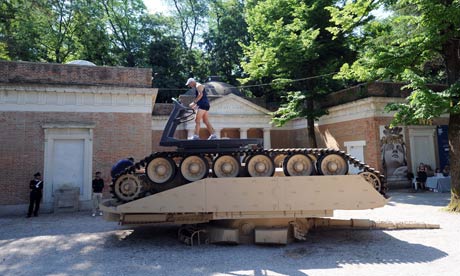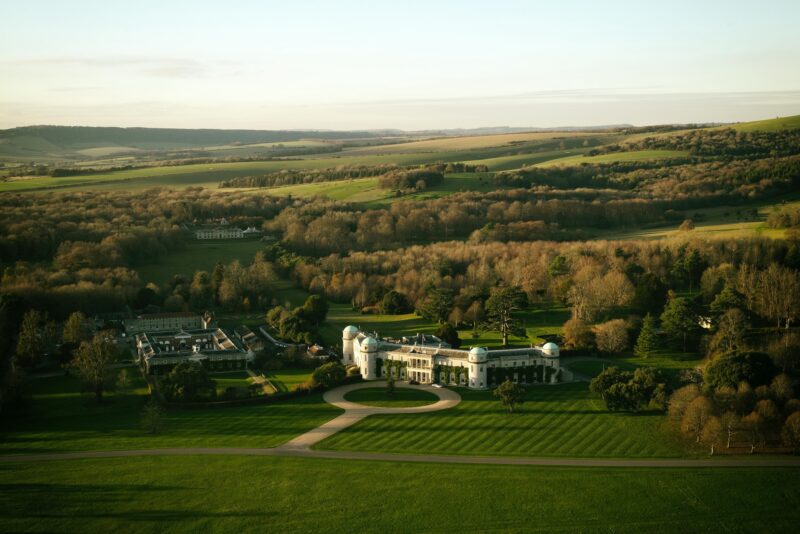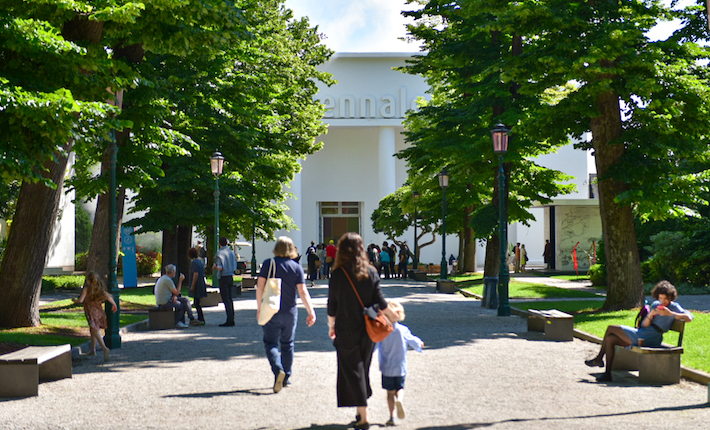
Image:Jennifer Allora and Guillermo Calzadilla’s Track and Field at the 2011 Venice Biennale. Photograph: Andrea Pattaro/AFP
A Centurion tank flounders on the lawns of the Giardini, massively overturned, its undercarriage exposed like a giant cockroach beneath the blue Venetian sky. The gun barrel, laid flat, looks no more lethal than a limp proboscis. But as you gingerly approach, the whole machine abruptly starts up into motion, propelled by a runner on a treadmill harnessed to the tracks. Deafening, violent, shocking even in its impotence, the work is called Track and Field.
This is the eye-opener to the US pavilion at the 54th biennale and the loudest and punchiest affront in the place. The Centurion is a British creation, but let that pass, perhaps as further evidence of the special relationship. For this is an art tank, with a strong conceit and a cunning pun of a title, yoking imperialism, mechanisation, personal/political goals and much more, with the overall notion of pounding the world.
By the Cuban-American duo Allora & Calzadilla, it could also stand as an emblem of this biennale. For Venice, this time round, is nothing if not political. It is dense with an art of rapid response. It might have looked quite different in January, for instance, before the Arab Spring and the fleet reactions of international artists from Andorra to Azerbaijan, showing here for the first time along with Bangladesh, India, Saudi Arabia, Zimbabwe and many others in what seems to be a global scramble to secure the last of the 20-year spaces the city is currently leasing for up to £1.4m in the newly converted outreaches of the Arsenale.
From al-Jazeera to CNN to BBC World, newsreel spools its way through the entire event, almost to the point of becoming a medium in its own right. Obama is in Ireland, then London, then back in the White House. Gaddafi appears and disappears in Tripoli. Strauss-Kahn takes the perp walk in Angel Vergara’s Belgian pavilion, in which TV news flashes across seven screens while a gentle paintbrush dabs away at the luminous glass surfaces, as if trying to make sense of the onslaught of appalling images of lust, violence, greed – the seven deadly sins in grim total – turning television into both the base and the source for a new kind of helplessly beautiful abstract expressionism.
There are dark memorials to the Libyan dead and banners on the facade of the Romanian pavilion decrying western hegemony in global politics and culture (a dig at the “choking-on-money mercantilism” of the biennale itself). Bahrain was forced to pull out, and Lebanon could not make it after its coalition government dissolved in January. At the Welsh pavilion, Tim Davies is showing omni-purpose military ceremonies reduced to the absurd as raw recruits march round and round in ever faster and more meaningless circles.
There came a point, in the long march through the Arsenale, where it even seemed as though one was watching the filmed burial of Bin Laden himself, somehow bootlegged into Venice, as two soldiers solemnly performed the exequies at sea. It turned out to be the remains of the Nazi Adolf Eichmann, secretly ejected as far from land as possible for exactly the same reasons, so there could be no future memorial and no nation could serve as a final resting place, a parallel most piquantly made in Israeli artist Dani Gal’s superb film Night and Fog.
At the time of writing, a young woman has just been released from jail in Saudi Arabia for agreeing to stop campaigning against the ban on women driving. No driving, no voting, and yet women are apparently allowed to represent the nation at Venice as if their work was as harmless as tatting. Sisters Raja and Shadia Alem have juxtaposed a twinkling oval lagoon on the floor against an upright oval of obliterating blackness that looks as if it could be snapped shut like a clam. The artists speak obliquely in the catalogue of “the black silhouettes of Saudi women” and the eternal light of Venice. One would not wish to understate the political content of this piece.
And nobody could ignore the dreadful testimony in the Egyptian pavilion, where video of Ahmed Basiony’s last performance – 30 Days of Running in the Space, in which the artist runs on the spot dressed in a bubble of polythene, his breath misting its surface – is interposed with footage he shot in Tahrir Square during the pro-democracy demonstrations. This is where Basiony was shot and died. May he rest in peace.
Reality for the biennale art crowd, such as it is, came on the VIP opening day as the vaporetti went on strike to protest against staff cuts. The Grand Canal flowed almost empty, just the odd gondola and barge, like some living Canaletto. The pavilions were eerily quiet, the Arsenale nearly deserted. Money stayed away, though it lurked in the monstrous yachts moored along the quayside, including Roman Abramovich’s palazzo-dwarfing liner.
In the Giardini, there were more publicists than collectors, pursuing more coverage than ever in the biennale’s century and more history. But eventually it was business as usual. The latest variation on the principle that art is a safe bet in risky times: even the catalogue bags are now hailed as limited edition “artworks”.
The art of the 54th biennale, by contrast, is generally sober, inventive and intelligent. There is a preponderance of installations and environments. More than one artist conjured the ordeal of the Chilean miners with lift shafts and underground chambers. Sigalit Landau dreamed up a salt bridge to unite Jordan and Israel across the Dead Sea; some poetic hope. In the US pavilion, athletes performed heroic contortions to turn themselves, ever so briefly, into human flags for the fought-over island of Vieques.
Japan had Tabaimo’s vast projections – a hybrid of animated manga and Hiroshige on acid – cascading down curved and mirrored walls in a dizzying fantasy of Japan “receding into isolation in the face of globalisation” (says the artist). Iraq’s inaugural pavilion had six artists’ interpretations of water, including a fine semblance of the rippling reflections beneath Venetian bridges ingeniously fashioned from ribbons and foil.
Across the lagoon, in Palladio’s great church of San Giorgio Maggiore, Anish Kapoor was raising the Holy Ghost with a cloud of smoke that spiralled and shivered up through the nave. In the Arsenale, one of James Turrell’s immense lightworks was sucking the crowds into its numinous pink void.
I thought the Dutch pavilion was a fantastic reprise of a Mondrian painting in three dimensions, connected by stairways, but that’s the problem with the forced harvesting speeds at Venice. Four more hours and I might have understood, from laborious texts and performances, that this was in fact a trenchant critique of cultural infrastructures.
Cindy Sherman was being turned into wallpaper, her various self-transformations blown up to billboard size in ILLUMInations (get it?), the main group show organised by the respected curator Bice Curiger. Germany’s artist, film and theatre director Christoph Schlingensief died of lung cancer last year so his pavilion became a memorial self-portrait.
Films from his career were screened around a cathedral of pews and altarpieces, crowned with Beuys’s hare and alluding to other artists at the heart of Schlingensief’s Fluxus oratorio. Harrowing, funereal, with the idea of art as tragic salvation, the experience was agonisingly oppressive and I was rapidly out of there.
The British pavilion is supposed to be Mike Nelson’s crowning achievement, partly because it so convincingly transforms that dainty tearoom of a building into a warren of interconnected backrooms of the sort you mind find in a Venetian workshop or a Turkish slum. Tools and benches, concrete floors and strip lighting, filthy mattresses and ancient tellies glowing in the windowless gloom: the atmosphere is of impoverished and unseen lives.
Not that there is anyone here, except the trespassing art crowd. You follow the clues – naked light bulbs, Turkish carpets, mysteriously marked calendars – through a labyrinth that seems to lead to the same empty chamber, except (of course!) that there are really two. Nelson has been doing this for so long he must know that the intellectual experience of his buildings within buildings is always countered by the human urge to work out the floorplan. And nothing dispels the mystery quite like having a guard warn against banging your head on the next low beam.
Generally atmospheric, specifically elusive: that’s what the installation should be. Each mise en scène is conspicuously designed to evoke claustrophobia, bewilderment, unease. Yet I felt not the slightest frisson. Nelson will one day make a great work, one that exceeds the spectacle of his flawless craftsmanship to transport one to another chamber of the mind altogether. But this is not it.
The dominant triad at Venice always used to be Britain, America and Germany. But Ireland, Wales and Scotland eventually got their own pavilions and Scotland is showing Karla Black, shortlisted for this year’s Turner prize, at her best with a palazzo full of sculptures, fashioned from soap, paper and even make-up, evoking Alps, stalactites and rococo architecture in cornetto colours.
Lately, though, France is the place to go and this year’s artist is surely its greatest: the veteran Christian Boltanski. The pavilion is filled with an immense and complex scaffolding around which images of newborns spool at a hectic pace, instantly summoning – the open structure is everything here – a vision of the brain reeling images through its unimaginable interstices.
One born every minute: that seemed the thought. But the numbers racking up in digital lights were running to the tens of thousands within seconds. And in one part of the pavilion, these images are spliced with those of adults, so that death and birth are appallingly comingled. Press a button and time stops momentarily so that you may look upon these faces. But eventually a terrible klaxon sounds and the machine grinds down. The images freeze and it now seems that the babies are not just sleeping but perhaps actually dead. Imponderable mortality made real, Boltanski’s work is profoundly affecting.
But the most devastating work in the whole of the 54th biennale is not by a living artist but a long-dead painter. Three Tintorettos have been hung in the Giardini for the first time, including The Stealing of the Dead Body of St Mark, with its apocalyptic lightning, fleeing figures and utterly reckless composition.
Tintoretto’s work is a thunderclap of a painting by an experimental genius. There is nothing to touch it here for newness.
guardian.co.uk © Guardian News & Media Limited 2010
Published via the Guardian News Feed plugin for WordPress.







